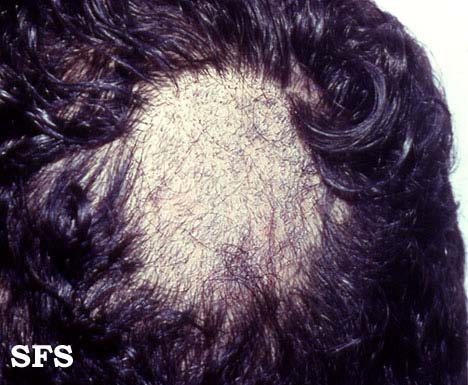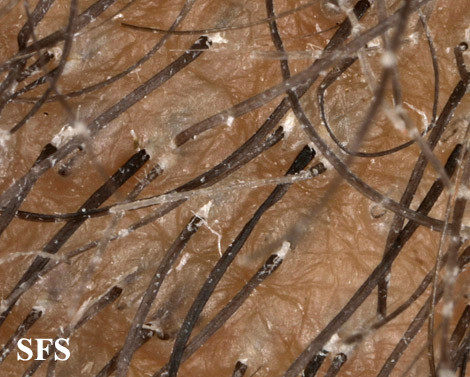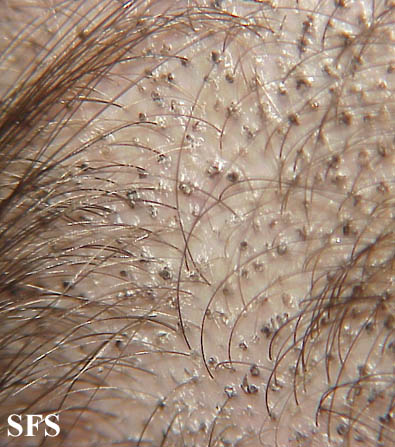Tinea Capitis (Scalp Ringworm, Hair Fungal Infection) Pictures
Fungal infections of the skin are common conditions that mainly affect the feet (athlete’s foot) and groin (jock itch). This occurs in both adults and children. Most of these fungal infections are caused by a type of skin fungus known as dermatophytes. These infection are referred to as tinea. Sometimes these infections are caused by yeasts in which case it is known as pityriasis or candidiasis, depending on the type of yeast that causes the infection. Yeasts are a different type of skin fungus from dermatophytes but cause a similar type of skin infection.
What is tinea capitis?
Tinea capitis is a superficial fungal infection of the scalp skin and hair that may also affect the eyebrows and eyelashes. It is caused by dermatophyte fungi. Commonly tinea capitis is known as scalp ringworm. The infection is commonly seen in children and sometimes infants as well but tinea capitis is rare in adults. Often there is hair loss at the affected area but in most cases this is temporary and will resolve with proper treatment of the infection. Tinea capitis is highly contagious and the fungi can be transmitted from person to person, and in some cases even from animal to person.
Meaning of scalp ringworm
A common term for tinea capitis is ringworm of the scalp. The term ringworm came about because the skin rash with a dermatophyte (skin fungus) infection is round to oval in shape with raised borders that gives it the appearance of a ring. The infection is not caused by a worm but by a fungus. The term tinea capitis means dermatophyte infection (tinea) of the head (capitis). It is mainly seen on the scalp but can extend to the eyebrows and eyelashes. The term tinea faciei more correctly refers to a dermatophyte infection on the skin of the face and tinea corporis on the body. Another common fungal infection known as tinea versicolor is actually an yeast infection mainly affecting the upper body like the neck, chest, upper arms and back. These terms are often confused.
The fungus in tinea capitis primarily affects the hair shaft and follicle, although the skin is also involved, while other tinea infections affect the skin on the different parts of the body. Dermatophyte fungi can be divided into anthropophilic and zoophilic fungi. The anthrophophilic fungi have a predilection for humans and is the more common type seen in tinea infections. It is easily spread from person to person. Zoophilic fungi are spread to humans through direct contact with animals but is rarely spread from one person to another. The fungi consumes the tissue of the hair shaft and may also involve the outer lying areas of the surrounding skin. Infections with dermatophyte fungi can also be divided into endothrix, ectothrix or favus infections depending on how the hair shaft is invaded. This is discussed further under the causes of tinea capitis.
Scalp ringworm causes
Tinea capitis is caused by a number of species of Trichophyton and Microsporum fungi. The pattern of invasion and damage to the hair shaft may differ among the species. This can be categorized according to the known patterns of invasion – endothrix, ectothrix and favus.
Fungus breaking hair
An endothrix infection occurs inside the hair shaft. The outer cuticle of the hair shaft is intact and causes the hair to break off just as the point where it emerges from the skin (follicular orifice). Fungal species that may cause this pattern of damage includes the different Trichophyton species :
- T.tonsurans
- T.violaceum
- T.soudanense
Fungus on hair shaft
Ectothrix infection spreads outside of the hair shaft where the outer cuticle is affected. Hair loss is not as prominent as it is with an endothrix invasion. Species involved includes :
- T.verrucosum
- T.mentagrophytes
- All Microsporum species
Honeycomb hair fungus
Favus infections also destroy the hair shafts but in a honeycomb pattern. It is caused by T. schoenleinii.
Spread of fungus
Tinea capitis is contagious and quickly spread among children with close physical contact. It is more likely to occur with the sharing of personal items like a comb or brush. It is not uncommon for outbreaks to occur in day care centers and schools. Poor hygiene is a contributing factor but not an issue in every child with tinea capitis. Pre-existing skin diseases of the scalp are not necessary for tinea capitis to occur but increases the likelihood of a fungal infection. Due to zoophilic fungi, exposure to pets may also be a risk factor.
Tinea capitis symptoms
The presentation of tinea capitis can vary among the different species.
- The scalp may appear dry, with red patches and scaly skin. Sometimes only the scaly skin is apparent and is therefore often referred to as dandruff. The patches are usually round to oval in shape and gradually enlarge.
- Hair loss may occur with the shaft breaking as it emerges from the skin thereby causing a black dot appearance on the balding area. The balding may only be temporary and resolve once the condition is adequately treated. Sometimes there may be smooth areas of hair loss.
- Favus presents with yellow crusts and matted hair.
- Parts of the scalp may become very inflamed, spongy and tender as if an abscess is present and this is known as a kerion. If a kerion is left untreated then there may be permanent scarring and hair loss.
Tinea capitis pictures
| Pictures of tinea capitis (scalp ringworm). Sourced from Dermatology Atlas (www.atlasdermatologico.com.br), courtesy of Samuel Freire da Silva, M.D. | |
 |
 |
 |
 |
Tinea capitis diagnosis
Scalp ringworm can be identified by visual inspection during clinical examination. A skin scraping or hair sample is examined under microscope to identify the presence of the fungi. Examination of the affected area with a Wood’s lamp may help to differentiate among certain species. However, a culture is the most effective method for identifying the species involved in the infection.
Tinea capitis treatment
Tinea capitis needs to be treated orally by the use of an antifungal tablet. The two commonly used oral medication is griseofulvin and terbinafine. It may need to be used for 4 to 6 weeks and sometimes even longer. Various shampoos containing zinc, selenium and antifungal agents may be helpful but will not eradicate the infection.





